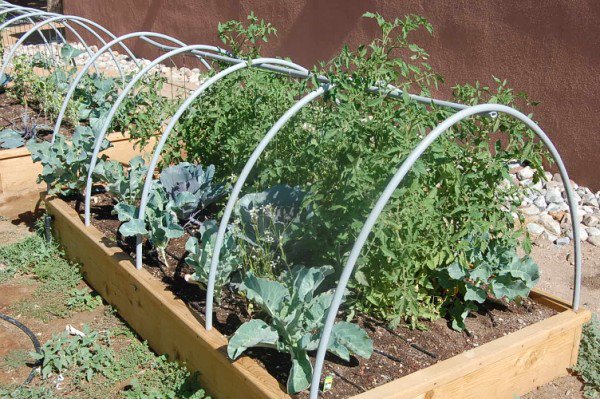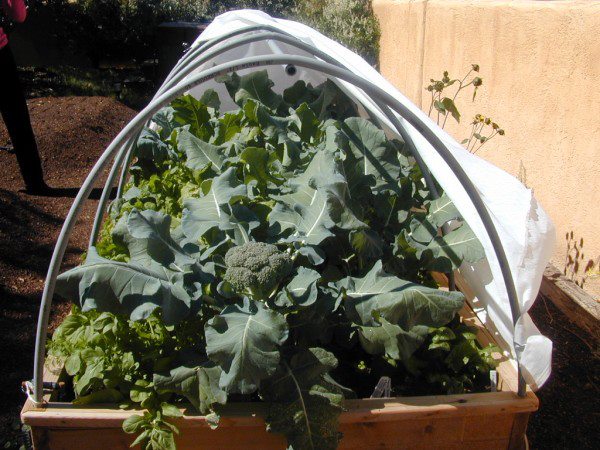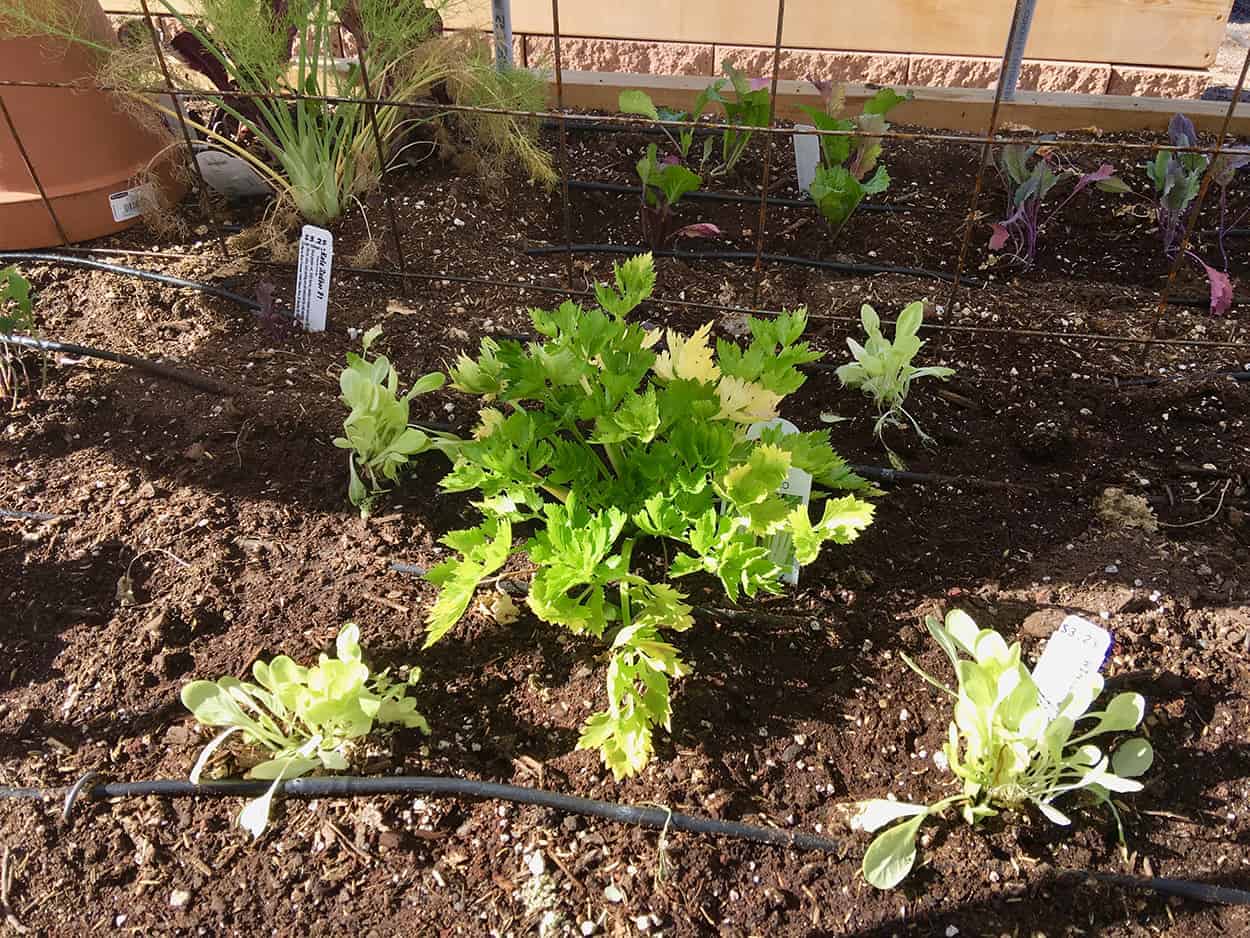Tips & Tutorials
Planting Your Raised Bed
Plant the unit ‘French intensively’. This means with little spacing in between the herbs and veggies to maximize the square footage of your unit, for increased production. The method I recommend for growing things like tomatoes and peppers, is to install a 6″x6″wire grid, from the bottom of the ridge pipe, down into the soil, and from end to end of the box. Leave the wire inset about 6” from either end, so that the covers do not come into contact with the stub wire ends. Attach wire to ridge with ‘zip’ ties. Plant the tomatoes, etc on either side of the wire, and as they grow, ‘espalier’ or weave them back and forth through the wire spacing. In this way, the plants won’t take up a lot of room, and when you lift up the cover, you’ll have a ‘wall’ of plants! It also gives you more bang for your buck, by increasing the grow area of your bed by another 50%!

Soil Mix of the Grow Bed
The mix I like to use for the 4’x8′ unit is:
- ¾ yd topsoil/compost mix
- 2- 2.2 cu ft bags Moonshine Potting Mix
- Sprinkling of Age Old Grow formula around each start for above ground plants, Fruit Finish for subterranean plantsI put in 1/2 the ingredients and mix thoroughly, and then the other 1/2 and mix.
Remember, like location, location, location, its all about soil, soil, soil!
- Use 1/2 the mix for a 4’x4′ unit
- Use 2/3 of the mix for the 4’x6′ unit is in between the two.
- Use 1/4 mix for a 2’x4’ unit

Complete Instructional Video of Raised Bed Setup and Assembly
Watering the Grow Bed
You can either hand water your Grow Y’own bed, or set it up on a 6” spaced drip line and timer system. I like both ways of watering, but the latter is easy, hands-free, and automatic. I plant next to each emitter- larger plants like kale and chard 1’ apart, and lettuces and herbs 6” apart. This way, each plant gets a proper amount of water and space to grow. I drill one end of the box, and feed a ½” blue stripe, irrigation hose into the unit. I then attach ¼” laser line with 6” emitters every 6” along the 1/2” manifold, and run them from end to end of the length of the box. I use an Orbit 2 dial timer at the faucet, and attach the ½” bluestripe to it. I set the timer for daily use in the Summer at between 2 and 10 minutes depending upon the size of the unit, and the water pressure of each home.
You don’t want to flood the bed in any sense, but simply lightly saturate it. In the Winter-time, you’ll water only when necessary, like when it looks like the plants are drooping or stressing. Once a month is not uncommon.
Never sog out the soil. This a contained environment like a terrarium, that holds and produces its own moisture. One way to check when to water is to stick your finger next to one of the plants, down about 1”- 1-1/2”. If it’s moist, don’t water. If its dry, give it a little! I have test-run a Parrot Flower Power device, that is a smart, wireless sensor equipped with a Bluetooth Smart Technology. It analyzes 4 criteria that are crucial to plant growth- soil moisture, fertilizer, ambient temperature, and light intensity. It works quite well, and takes the guess work out of ‘when to water, fertilize, or adjust the ambient heat and light situations.

Seasonal Plantings
Spring and Summer
Grow any of these greens ‘n things under your custom Spring/Summer Cover:
| Beets Broccoli* Cabbage* Carrots Cilantro Greens Kale |
Onions Peas Radishes Spinach Swiss Chard Beans |
Cucumbers* Lettuce Herbs Melons* Peppers Squash* Tomatoes |
Click here for a letter from Ken to Spring Growers.
*Note from Grow Y’Own regarding Broccoli, cabbage, cucumbers, melons, and squash: You certainly can grow these plants in your raised beds, but they take up a lot of room. It’s best to start them in your raised bed early in the season and transplant them outside after the last frost.
Fall and Winter
Grow any of these chilly-season veggies under your custom Winter Greenhouse Cover:
| Arugula Beets Brussel sprouts* Chard Dandelion Endive Escarole Carrots Greens (mustard, turnip) Swiss chard |
Radishes Broccoli* Cauliflower* Herbs Kale Kohlrabi Leeks Lettuce Mache Mizuna |
Onions Parsley Raddicchio Sorrel Tatsoi Spinach Cabbage* Garlic Lettuce Peas |
Click here for cold weather heating tips.
*Note from Ken regarding broccoli, brussel sprouts, cabbage, and cauliflower. You certainly can grow these plants in your raised beds, but they take up a lot of room!
A list of things to sow for your Fall/Winter garden would be…
- Sow in July: Beets, broccoli, carrots, cauliflower, kale, parsnips, swiss chard
- Sow in August: Arugula, cabbage, endive, lettuce, mustard, onions, spinach,turnips
- Sow in September: Fava beans, carrots, peas, radishes, garlic …and much, much more
